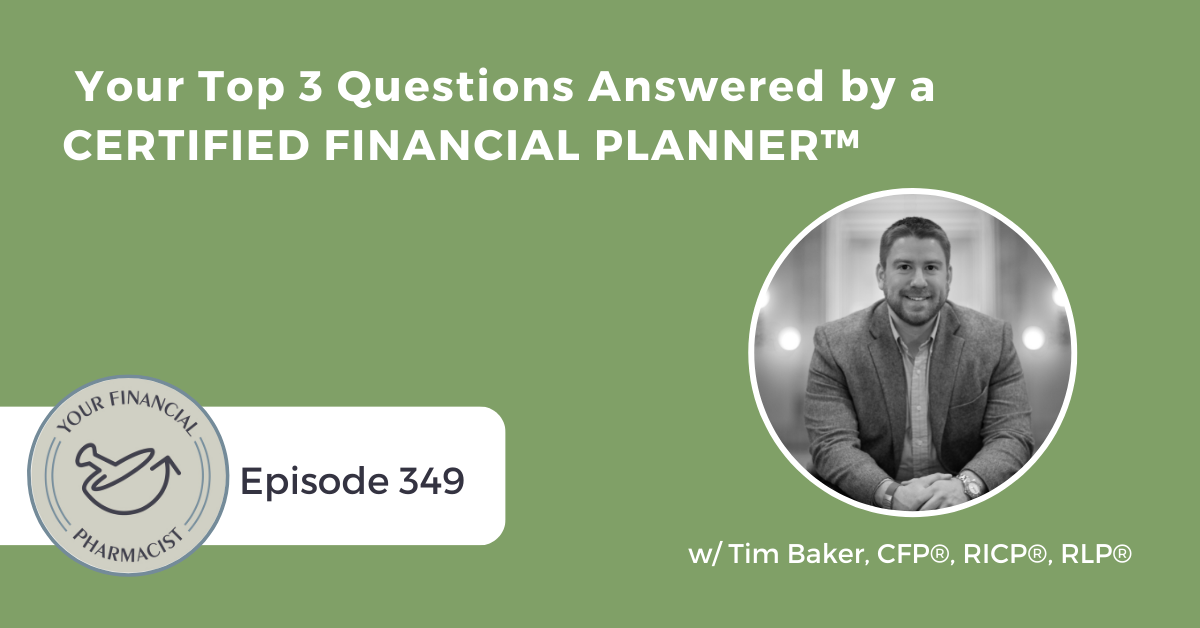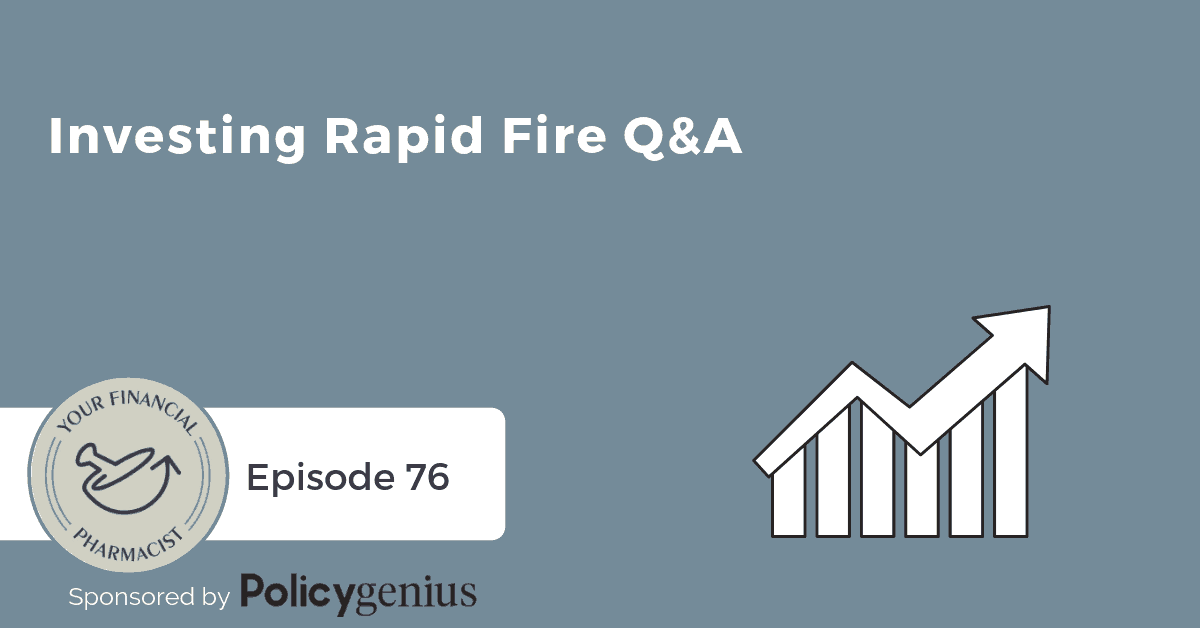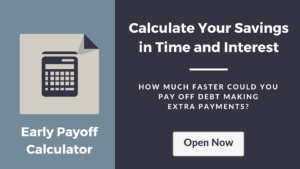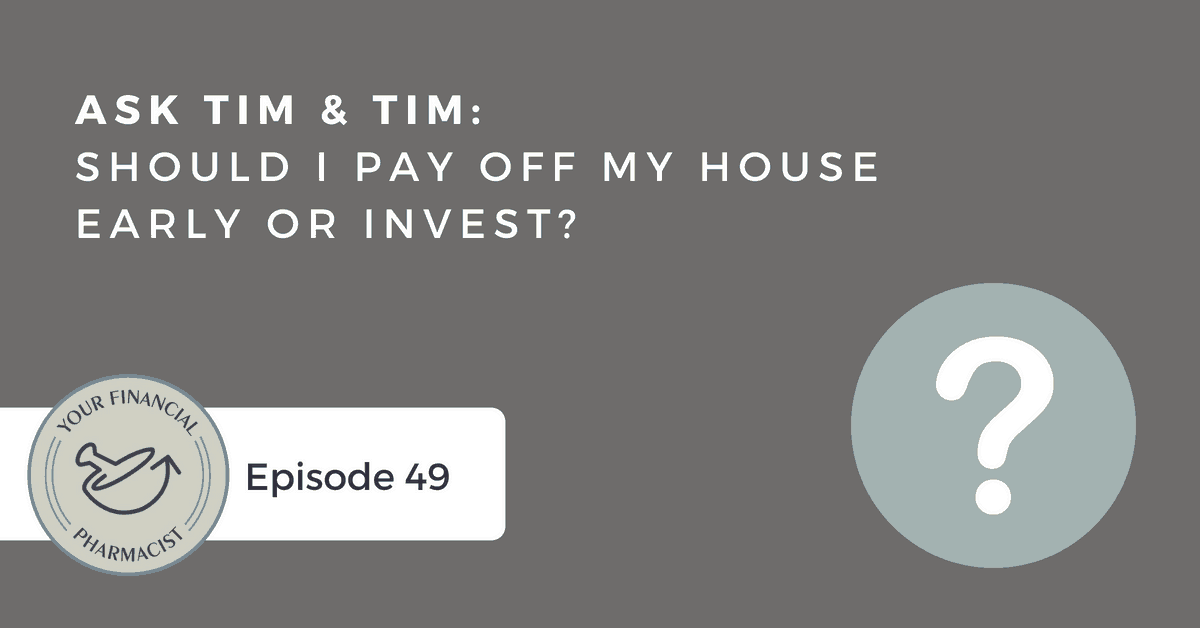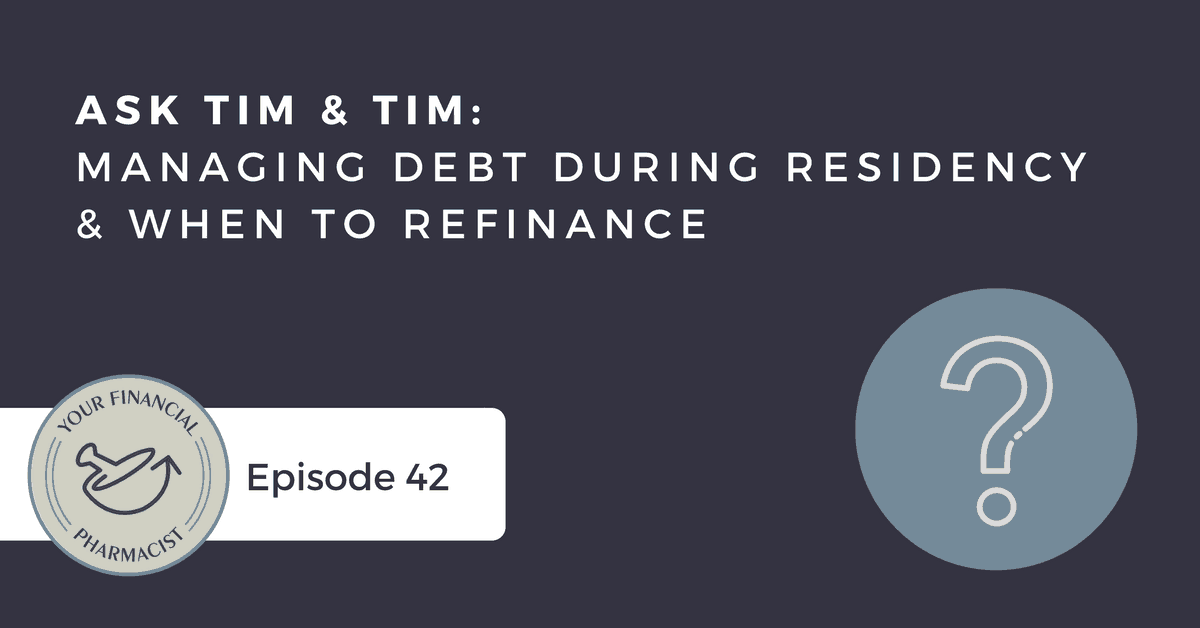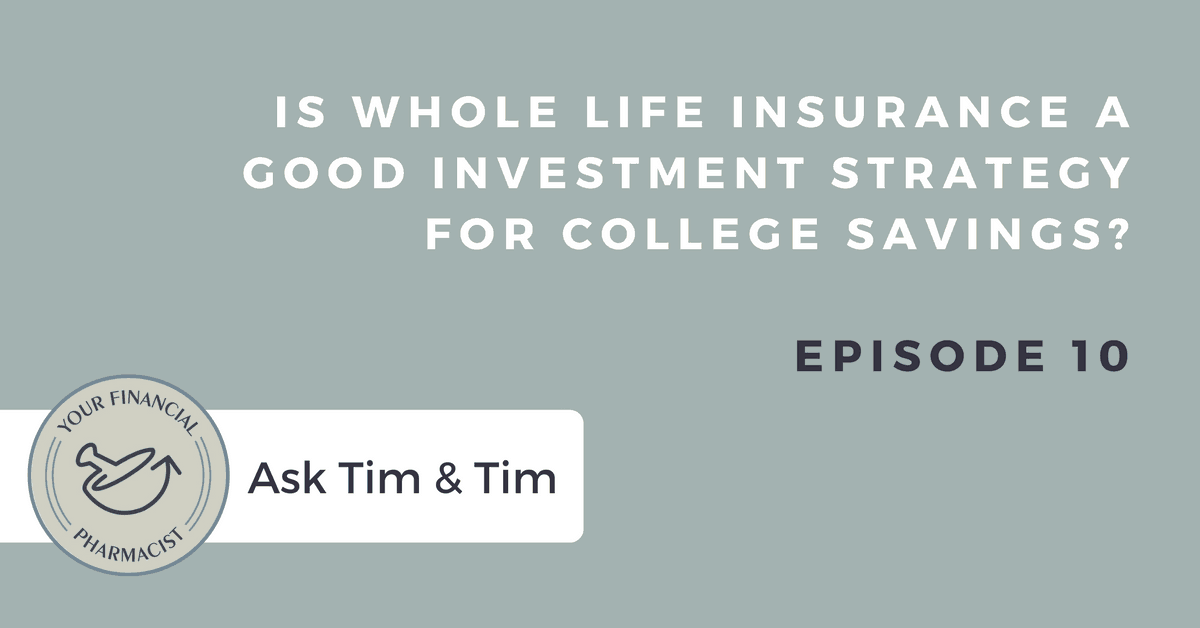YFP’s Tim Baker addresses key questions from the community, covering retirement savings, cost of living, and the importance of the nest egg calculation.
Episode Summary
On this week’s episode of the YFP Podcast, host Tim Ulbrich is joined by YFP Co-Founder and Certified Financial Planner, Tim Baker, to dive into some of the most common questions from the YFP community. He covers topics ranging from debt repayment to investing and retirement planning in three key questions:
- How much do I need to save in order to retire? How do I determine what is enough?
- The intricacies of cost of living and understanding the income you’ll have in retirement.
- Why the nest egg calculation is crucial in financial planning.
Our discussion also delves into the pros and cons of paying off low-interest debt, such as student and auto loans, versus investing. Tim Baker also shares the strategies for prioritizing debt repayment, retirement savings, and saving for a house down payment.
In a particularly insightful segment, Tim and Tim tackle a question from a listener with a $200,000 student loan balance, where Public Service Loan Forgiveness (PSLF) isn’t an option. Tim Baker shares his perspective on weighing the decision between paying off the loans and pursuing forgiveness over 20-25 years, including the potential tax implications.
Join us as we navigate the complexities of financial planning and empower you to make informed decisions for a secure financial future.
About Today’s Guest
Tim Baker is the Co-Founder and Director of Financial Planning at Your Financial Pharmacist. Founded in 2015, YFP is a fee-only financial planning firm and connects with the YFP community of 12,000+ pharmacy professionals via the Your Financial Pharmacist Podcast podcast, blog, website resources and speaking engagements.
Tim attended the United States Military Academy majoring in International Relations and branching Armor. After his military career, he worked as a logistician with a major retailer and a construction company. After much deliberation, Tim decided to make a pivot in his career and joined a small independent financial planning firm in 2012. In 2016, he launched his own financial planning firm Script Financial and in 2019 merged with Your Financial Pharmacist. Tim now lives in Columbus, Ohio with his wife (Shay), two kids (Olivia and Liam), and dog (Benji).
Key Points from the Episode
- Debt repayment, investing, and retirement planning.
- Retirement savings and investment strategies.
- Retirement planning and nest egg calculation.
- Retirement planning and the “Nest Egg Exercise” to connect long-term goals with current actions.
- Prioritizing debt and investing strategies.
- Prioritizing debt payoff vs. investing for financial freedom.
- Financial planning and prioritizing goals.
- Managing $200,000 in student loans without PSLF.
- Student loan debt and financial planning.
Episode Highlights
“I think what, what sometimes happens, Tim, is that we try, we try to do a lot. We try to do a little bit of a lot of things versus a lot of like one or two things. Yeah. So I think working with a planner to help you prioritize is going to be really important.” – Tim Baker
“So I think the best thing, and we we’ve done this a lot, and when we speak, Tim, the best I think way to determine if we’re on track to retire is to do a nest egg nest egg calculation” – Tim Baker
“But I do think that that push and pull between today and tomorrow is really important. So let’s focus on that trip to wherever; let’s focus on the down payment for a real estate property or whatever that is, like those things, I think, have to be part of the plan as well.” – Tim Baker
“The cons of paying off debt, I think, is the opportunity costs of, like, what you might miss in terms of if you were to invest that, especially if the interest rates are really low, and then just kind of just overall money,less money for investments. The pros, I think, of investing, is potentially higher returns, although not guaranteed, compounding growth, potential tax benefits, if you’re putting in things like 401Ks and IRAs.” – Tim Baker
Links Mentioned in Today’s Episode
- Episode 272 – How Much is Enough
- YFP Planning – www.yfpplanning.com
- YFP+ – yourfinancialpharmacist.com/membership
- Subscribe to the YFP Newsletter
- YFP Open House on March 14, 2024 at 8:30pm EST – yourfinancialpharmacist.com/openhouse
- YFP Disclaimer
- Tim Ulbrich on LinkedIn
- Tim Baker on LinkedIn
Episode Transcript
Tim Ulbrich 00:00
Hey everybody, Tim Ulbrich here and thank you for listening to the YFP Podcast where each week we strive to inspire and encourage you on your path towards achieving financial freedom. This week, YFP Co-Founder, Director of Financial Planning and Certified Financial Planner Tim Baker joins me to answer your top three financial questions. During the show we tackle pros and cons of paying off low interest rate debt versus investing strategies to optimize student loan repayment for those not pursuing Public Service Loan Forgiveness and how to determine how much one needs to save for retirement. Before we jump into the show, I want to make sure that you’re aware of our next YFP Open House that I’m hosting on Thursday, March 14 at 8:30pm. Eastern. If you’re wondering how working one-on-one with a financial planner can help you achieve your financial goals, the best place to begin is by signing up for our open house. You can do so by visiting YourFinancialPharmacist.com/openhouse.
During this open house, we’ll help you gain clarity on your vision for living a rich life and how the financial plan can become the engine for achieving that vision. We’ll also help you determine how much is enough when it comes to retirement planning whether or not you’re on track. I’ll be taking the group through nest egg calculation. You can learn about the nuts and bolts of hiring a financial planner including what to look for different types of planners that are available and why fee-only planning matters.
And finally, we’ll cover an overview of YFP services, including our financial planning, and tax and accounting services. Make sure to sign up to attend live. We won’t be recording this workshop. For those that attend, they’ll receive an interactive workbook as well as a free resource: Where Should My Next Dollar Go? that will help you assess your overall financial well being and provide clarity on how to efficiently deploy cash, avoid overspending and prioritize various goals. Again, you can register for this Open House on Thursday, March 14 at 8:30pm Eastern by visiting YourFinancialPharmacist.com/openhouse. Alright, let’s jump into today’s episode.
Tim Ulbrich 02:04
Hi there, Tim Ulbrich here. Welcome to this week’s episode of the YFP Podcast. I’m excited to welcome Tim Baker back to the mic as we’re gonna put him on the hot seat with some rapid fire Q&A with some of those common questions that we get from our community, including those around debt repayment, investment, and retirement planning. Hey, Tim, it’s been a while since we’ve had you on the show, what’s new, what’s exciting?
Tim Baker 02:24
What’s new? We’re in the throes of tax season. So I’m, we’re busy there. I’m talking to a lot of potential clients coming on board. Baby number three is about a month away, Tim. So we’re preparing for that. I joke we have about 1000 projects that we have to complete before the baby gets here. So you know, kind of maneuver in my my wife’s lifts list here. So but yeah, all good. Thanks. No complaints.
Tim Ulbrich 02:55
Well, we’re excited to jump into these questions. I know it’s a busy season for you, busy season here for YFP as you mentioned in the midst of tax season. And, you know, we’ve been, we’ll talk at the end of this episode about our YFP Plus community, our new community that we’ve been offering now for a few months. And it’s been really exciting to see the questions and the engagement that that group has, and one another jumping in answering those questions. And we wanted to pull three of the most common questions that we get, whether it’s inside of that community, whether it’s, Tim, questions that we get when we’re speaking that come up on repeat. And so they may be variations of these, but you know, common questions around things like hey, how much do I need to have saved for retirement? What are the pros and cons of paying off debt versus investing? That’s probably the most common question that we get. And, you know, what should I do with my student loans? And how can I best optimize the repayment strategy? So let’s jump into these one by one. Tim, the first question that we have is a big one, but how much do I need to save in order to retire? How much is enough? And how do I begin to determine what that number is?
Tim Baker 03:57
Yeah, so I mean, it depends. Just gotta get that out of the way, right. I mean, this is such a multivariable thing. I think it’s just really hard to determine, you know, without a, you know, pretty deep level analysis to be honest Tim, you know, I know, you know, I’ll talk through some rules of thumb here and things like that. But, you know, like I was talking to a couple last night, and, you know, I think the the wife, the pharmacist was, like, you know, I kind of want the same level of comfort in retirement that I have today in terms of like my standard of living and the husband, the spouse, was like, I could live in a tent and be completely content. You know, so like, so like, that’s, that’s a big thing. You know, like if, if what your need is in retirement, you know, you could have enough saved today, Tim, like it’s it really don’t know. So the variables there, some of the variables could be you know, the standard of living the time in retirement. There’s a lot of clients that we work with that like, will say like, Hey, like I don’t know how long I’m going to be around because of my family history. So we, you know, we put that in, in in play, taxes, inflation unexpected, you know, expenses, a lot of that can be medical, even the inability to work so that, you know, a lot of people, when they’re when they’re doing this calculus, they’ll say, Oh, I’ll work till 70. Or I’ll work part time. And the stats say that 40% of the people out there are going to going to stop working earlier than they think that they do. So you know, what I always do, there’s, there’s lots of fancy ways to kind of calculate this. And you know, if you’ve ever heard of Monte Carlo analysis, this is where we, we simulate portfolio returns 1000s of simulations and say, with, you know, X percent probability of success, we typically want, anywhere from 70 to 80% probability of success, you might say, Tim, why not 100%. Typically, if we’re, if we’re lower than, you know, 70%, we’re going to adjust the plan accordingly, in real time to get it to the end of that.
So I think the best thing that and we we’ve done this a lot, and when we speak, Tim, the best I think way to determine if we’re on track to retire is to do a nest egg nest egg calculation. And this was really born out of, Tim, like, back in the day, when I started advising people on their on their, you know, retirement stuff. What I learned from a mentor is we would say, hey, based on your based on these assumptions, you need $3.5 million to retire. And then we would just move on to the next thing. And I would see the, the look in people’s eyes were like, that number just didn’t hit the mark at all, like it was just like, it was kind of equated to like student loans where it’s just like Monopoly money, that doesn’t make any sense to me at all. So what I started to do is I would take that number, and then I would kind of use another time value of money calculation to discount it back to a number. So if you’re the client, Tim, a number for Tim in 2024, that actually is digestible to you, that’s palatable to you that says, okay, like that makes sense. And typically, what we’re doing is that we’re comparing, you know, what you’re putting into your 401 K, your IRAs, what you already have, you know what your allocation is, so we can kind of make some assumptions on performance returns, how long you’re going to work. And then we can say, hey, you’re on track by this amount of dollars per month, or you’re off track by this amount of dollars per month. And obviously, that that hill gets steeper, if we’re off track, the closer that we get to our target. So, to me that that’s a huge thing to actually connect the dots to, like when I ask people like, are they on track? A lot of people say I have no idea or they’ll say, like, I’m using a calculator, that typically is not a great indicator of where they’re at. So, but I think a lot of this goes back to kind of, you know, move the answer forward is like, you know, what do you need, you know. A lot of the estimates, you know, a lot of the estimates will say, you know, a lot of retirement planners will say, hey, you need 70 to 80% of your pre-retirement income in retirement. And that’s typically the reason for that. It’s like, you’re typically saving 20, 30% of your income, pre retirement, like so leading up to the years of retirement. And you’re not doing that in retirement. So, but a lot of that, Tim, also misses the mark, right? Because it’s like, alright, well, if I’m, like, 20-30 years from retirement, what does that even mean to me? Right. But if you take, you know, I did a kind of a, an example here, if you’re making $125,000 today, and you have a 30 year career ahead of you, and you get a 3% cost of living adjustment every year, in 30 years, that equals $303,400.00. Three or three 400.
Tim Ulbrich 08:55
Almost hard to believe, right? When you when you put the numbers on that.
Tim Baker 08:58
Yep, But then if you look back 30 years, like look back at, like, what a total cost of like a house was or like, what the… you know what I mean? Like, so you have to, you know, it’s perspective, right? So, so 30% of that $303 is about $212. So, essentially, what you need is $212 for 30 straight years, so every year $212. And then we had to, you know, account for inflation and things like that.
Tim Ulbrich 09:22
$212,000?
Tim Baker 09:24
$212,000. Right. So you need a portfolio. So if you just do it in simple terms to earn 12 times 30 Like, that’s kind of like, that’s a very, you know, linear way to look at it. But then you have to, you know, factor in things, you know, like variable expenses and things like that. So, what a lot of people will point to which, I don’t love it, because I think it can steer people wrong, but I think at least gets a like a foundation of where to think about this is the 4% rule. So the 4% rule is, you can withdrawal 4% of your savings in the first year retirement adjusted for inflation ever year thereafter, to ensure that your saving, you have enough saved for 30 years. So the way to kind of backwards plan to that is if you multiply your annual retirement expenses, so let’s say you need 40, that let’s say you need $60,000 per year, let’s say 20,000 of that comes from Social Security, then we need $40,000. $40,000 times 25 years, so we’re just doing the 4% inverted is a million dollars, or a million dollars times, you know, point 0.44% is that $40,000. So that’s a way to look at it. But again, like, I don’t know, if that does a great job of, you know, planning for longevity, you know, there’s a lot of there’s a lot of errors in that, you know, in that assumption, but I think it’s a good place to start thinking about this. So, I mean, it’s a, it’s a really big question that has a lot of, you know, at anytime that you look at something over, you know, 2030 years, I guess, if you’re closer to this, maybe maybe the questions a little bit easier to answer, but, you know, looking at expenses, you know, looking at budget, the budget never goes away, you know, people are like ugh budget, you know, scenario analysis, I think all of those things kind of play into this.
Tim Ulbrich 11:10
Again, this is why I love as you mentioned, the the nest egg exercise, you can see the connections that people start to make in that exercise. Now, of course, especially if we’re looking over a long horizon, right, 20-30 years out, or even if it’s 10 years out, like things are going to change, this is not a one and done, you know, type of thing. We’ve got to be looking at it on a regular basis. But when you’re able to take people from that overwhelming shock number, right, 3 million, 4 million, 5 million to as you said, Hey, here’s what we need to be doing this year and actually, this month. Like this is what we need to be doing based on what we have saved, based on a set of assumptions that we obviously have to think through and think about risk tolerance, capacity, all those kinds of things, based on what we choose to assume or not with Social Security, you know, based on what you’re getting through your employer, all these things are going to feed into where we at currently, and what do we need to be doing per month. And, you know, I did this recently, during an Open House that we did in February, I’ll be doing it again, in our next open house coming up on on March 14, again, you can register for that yourfinancialpharmacist.com/openhouse.
And what’s fascinating about that is I can see this come to life, when people start to just see how these numbers are calculated and see the assumptions in place. Because, again, we’re actually making it mean something today, right? When we look at a number per month, we can start to see how that does or doesn’t fit in with the budget, we might not like that number. But we can start to actually work with that. And in fact, sometimes we find out through this exercise that people are over saving, you know, and there’s a conversation to be had there about, hey, how do we feel about it? What other goals are happening? And might we shift around, you know, different priorities? And then you can toggle some of these factors like, Hey, I said, I wanted to retire at 67. But what happens if it’s 62? Or 58? Or, you know, hey, I’d like the work that I’m doing, and I don’t really see myself going from full time did nothing for 30 years. What if I’m working part time and having an income? And these changed things significantly when you look at these calculations.
Tim Baker 13:08
Yeah, I mean, if I do say so myself, I think it’s a great tool. I think it was born out of like the misconnection between that big number in the future and what we’re doing today. And I think to your point, like being able to, like toggle those levers and pull those levers, you know, whether it’s, you know, working longer working less, you know, dialing back things, you know, down up things like I think it’s really cool to see. And to your point, yeah, we’ve had a lot of clients that have definitely, you know, we talk about, you know, living a wealthy life today and will live in a wealthy life tomorrow. Sometimes the calculus shows that they’re really focused on living a wealthy life tomorrow, in spite of today, meaning like, you know, I think it’s rare for a financial planner to say like, Hey, you’re saving too much for retirement. But I do think that that push and pull between today and tomorrow is really important. So like, let’s focus on that trip to wherever let’s focus on you know, that, you know, down payment for a real estate property or whatever that is, like the like those things, I think, have to be part of the, of the plan as well. So yeah, it’s a great question to ask. It’s just really hard to, to to answer without, you know, a lot of detail. A lot of, you know, what’s the balance sheet look like? What are the goals and, you know, go on from there.
Tim Ulbrich 13:14
It is.
Tim Ulbrich 14:34
If listeners want to dig deeper on this topic, first love to have you join us at the Open House. Second, we’ve covered this as a stand alone topic on the episode on the podcast before Episode 272. Tim and I talked about how much is enough and how do you determine that. We’ll link to that to the show notes. Make sure to check out that episode as well. Our second question we have as I mentioned before, probably the most common question that I get when I’m presenting is Hey, what are the pros and cons of paying off low interest debt, such as a student loan or auto loan versus investing. Furthermore, how do you think about prioritizing strategies for paying down debt, saving for retirement and saving for a house down payment? Tim, I’ll add to this before you jump in here that this is a really common question that we see, especially among, you know, those within that first 10 years of graduation, right. They’ve got a lot of things that are coming at them. I’ve got, you know, a bunch of student loans, I’m looking at buying a home, you’re telling me that I should be investing in saving for the future? I need an emergency fund. How do I begin to prioritize and weigh all these things? And, again, before you say, it depends, like, I think this is an example question where the value of planning is so important, because we got to get all those things out of our head on the paper, so we can start to plan. So what are your thoughts here?
Tim Baker 15:46
Yeah, I mean, I always look at debt as like a spectrum. I think you have, you know, good debt, which, you know, I would I would categorize as, like a mortgage. I would still put student loan debt in there, because, you know, a mortgage is a, you know, typically appreciating an asset that you can, that you’re living in, raise a family. Student loans, typically, you know, the price of doing business to become a pharmacist, you know, higher levels of of income, you know, post degree. But then as you go like, like auto loans, again, again, these are used assets that are typically depreciating. You’re typically paying higher interest than you have in the past, but it serves a function of like getting you to work. But then as you go, it might be things like, debt for furniture or other types of personal loans. And then credit card debt is typically at that, you know, other end of the spectrum of bad debt, where it’s, you know, you’re typically, this is the purchase of of wants not necessarily needs, or, you know, it’s there because of a lack of an emergency fund or kind of planning, planning for those unexpected things. So, you know, I think like, where you sit, where you draw the line between good debt and bad debt, it’s going to different be different for everybody. You know, typically, it’s, it’s the car to the right is good debt. So car, student loans, mortgages, are okay. And then everything for the left is not. Some people will put cars like a bad debt. So I think it just depends on what your again, what your goals are, what your what your aspect of debt. You know, I was asked recently by a prospective client about like, you know, hey, was watching something that Dave Ramsey said about paying off, you know, a mortgage that’s less than 3%. And he’s very, paints with a broad brush and said, like, you know, really any debt, you’re kind of a slave to the master is kind of how he describes it. And I think like, there’s a psychological thing of this, like, if you if you feel like that debt, is preventing you to be financially free, that I would treat that differently than something else, you know, like, I have no qualms about sitting on my two and a half percent mortgage for 30 years, I just don’t. So I think if we look at this, like the pros of paying off debt, versus invest in, you know, the paying off debt, it’s a guaranteed return, right? So if your debt is 6%, that’s, you know, you’re not necessarily gonna get that in the market consistently. So it’s a guaranteed return. I think it reduces financial stress. So eliminating debt can reduce stress and kind of simplify your finances. You do, I think, if you are completely debt free, I think you can you operate differently, you think you look at the world a little bit differently than if you have, you know, multiple liabilities. That’s kind of, you know, weighing on you and we see this with student loans, Tim, right. Like, you know, I feel suffocated, because I have this $200,000 in debt. The cons of paying off debt, I think, is the opportunity costs of like, what you might miss in terms of like, if you were to invest that, you know, especially if the interest rates are really low, and then just kind of just overall money, you know, less money for investments. The pros, I think of investing is potentially higher returns, although not guaranteed, compounding growth, potential tax benefits, if you’re putting in things like 401Ks and IRAs, The cons are again, market risk, there’s no guarantee. And, you know, complexity, like you know, if you’re just paying off debt, you know, a lot of people will make investing more interesting or sexier than it needs to be I look at as an as an investment as it should be super boring, but not everyone does that. A lot of people don’t do that. So that’s, that’s kind of my, there is no right or wrong answer. I kind of have my own biases.
When I’m working with a client, I’ll look at their risk tolerance. I’ll look at what their goals are. I’ll look at like, what are they saying to me? If they’re saying things like, this debt keeps me up at night, I’m gonna treat that very differently than if someone’s like, yeah, like it’s whatever. But there is a mathematical component to that as well. In terms of prioritize and financial strategies or just get the financial, like, what do we do, you know, for paying down debt versus saving, you know, I was speaking to, you know, a prospective client the other day, and they have real estate, they have some investments, they have a brokerage account, no emergency fund. So like, we’re we’re doing steps, six, seven, and eight, before we’re doing step one, really. So building an emergency fund, having a high yield savings account with, you know, those non-discretionary, you think expensives, just stowed away. Super important. That’s, that’s a foundational thing. I think from there, it’s also like the consumer debt, so like credit cards, you know, furniture debt, whatever that looks like, I think is really important, because it’s typically higher nterest that you want to get get out from underneath.
I would also put taken advantage of the employer match up there, like, you know, most of the time, I think that is really, really important to get the free money. But still see people that don’t take advantage of that. And then I think looking at higher interest debt, paying that off. So, you know, maybe that is a car, you know, we’re seeing, you know, car rates, I think you you mentioned it in YFP plus community, just what those rate rates are. Shocking, you know, they’re high. So I assume, yeah, I would I, I would pay that off before I would go into the market. So I think that that to me, and again, like the one thing that the questioner asked, you know, it’s like, what about saving for retirement, again, I kind of look at, get the match. And then I look at it as that as you are navigating these other things to me, in the back of your mind, it should be a race to 10%. Like, get the match, which may be 5%. But then you really want to get to 10% as quickly as possible, and then assess from there. And then I think, like, to me saving for a house down payment. That’s a really tough one to prioritize, Tim, because oftentimes with this one, like, like you’re, you, you rationalize it, you know, you rationalize your decision. So like, it’s a super emotional decision, once you start going down the path of looking at houses, being a Zillow warrior, actually go into houses, like those timelines get cut overnight. And I always joke, like, I was talking to a prospective client. And they were like, Yeah, I want to buy a house in the next two or three years. And I talked to them two weeks later, and they were under contract. So to me, like, if that’s important for you, I would put that to the top, you know, put that at the top of the list, you know, and prioritize that. I think what, what sometimes happens, Tim, is that we try, we try to do a lot. We try to do a little bit of a lot of things versus a lot of like one or two things. Yeah. So I think working with a planner to help you prioritize is going to be really important. And it’s hard to do. Sometimes it’s hard to do that when you’re stuck inside your own head, or even with like a spouse. So sometimes that you know that that third party objective viewpoint to help you guide guide that conversation, I think is important. But again, there’s really no right or wrong answer here. It’s just tailoring to like when I say it depends. What I mean by that is, you know, it depends on what your balance sheet are, like, what your balance sheet looks like, and what your goals are. And unfortunately, you can’t like look at a neighbor or a colleague, because like you’re going to be different. You are a unique snowflake. So you know, your your experience, your life experience, your your finances are going to be different than than everybody else’s. And I think, you know, developing a plan that navigates that is super important.
Tim Ulbrich 22:39
Yeah, Tim, the visual that comes to mind, as you’re talking and I alluded to this, when I asked the question is, you know, we so often live with all of these competing priorities that are swirling in our minds, right? Guilty as charged. And it really is a step that often is hard work. But it’s really important because we’re a third party can be so helpful for us to kind of get out of our own way and make sure we’re looking at all the factors, making sure we’re not thinking of things in a silo. But it’s like, we got to put all the puzzle pieces out, we got to get them out of the box. So we can start to figure out how they actually come together. And then to implement the plan, looking at our cash flow, looking at our goals and things to actually begin to execute on that. But we tend to go into execution mode, without really considering all the pieces and parts and how they impact one another. And this sounds easy, but it’s not right. You know, in this question, you know, we’re thinking about paying down debt, you know, and that could be more than one type of debt. We’re thinking about, hey, when might we buy a home we think about saving for retirement, when you look at the percentage of take home pay that these things will take up it is huge. These are these are big decisions. And we’re not even talking about other types of goals, right vacation, travel, what else is going on the financial plan, so I feel like there’s such an important step here of, before you start running in any one direction. Hey, let’s get on with This down on the paper. You know, you did this for Jess and I back in the day, like, let’s create a prioritized list of these. What’s the target? What’s the goal? How much do we need? What priority, how much per month? And then we start to actually create the buckets and the mechanism and the thing to actually make these come to life. And when you’re doing that, and you’re automating that, I can’t even adequately describe the feelings that come when you know that that system is in place working for you.
Tim Baker 25:26
Yeah and I think like to go back to the first question, like, we’ve had conversations with clients that like, you know, they’re saving so much for retirement, and they’re like, we can actually do a little bit less than get into the house sooner. Right. So like, like, if you think about it, like, my, my Pop Pop back in the day, like he had a pension, there was no such thing as 401k is like, all of these other things that have like, like, made financial, you know, even my parents, like, it’s very different. Now, you go into the workforce, and you have 30,000 things that are like, like, vying for your attention and your your dollars. And it’s just different than what it was before. And now, like the onus, especially on retirement is up to you versus like, your employer. But it’s also like, a lot of the advice that that you’re getting is from, like, the old generation of like, hey, buy a house, make sure you’re saving for it, and those are all good things. But the world is different now. And I’m not saying that, like, that’s, that’s bad, that’s bad advice. But like, you got to kind of have to, like, you know, walk to your own tune, so to speak. And I think like, a lot of people get get anxiety because they’re like, I’m not like, I’m not doing enough here. I’m not doing enough here. And, you know, I think like, if you’re doing a plan, you’re doing enough, right.
And I think part of the part of the great thing about plan is that you are slowing down in the day to day of like busy living and objectively looking at your situation and reflecting, self reflecting or forcing to reflect of like, Hey, are we on the track that we’re supposed to be on. And also to like, celebrate the wins, like, you know, when we start with a client, you know, the the first two meetings that we go through is what we call Get Organized, where we’re building out a nice clean balance sheet of all the assets that we own, minus all the liabilities that we owe. That’s our first data points. Think of that as like the before picture. And then the second meeting is what we call Script Your Plan is all about, okay, now that we know where we’re at, where are we going, so let’s talk about you want to buy a house, you want to have a family, you want to be able to retire at this age, you want to be able to, you know, build your real estate empire, you want to be able to do XY and Z. And once we have those two foundational thing in place, the answer “it depends,” then transforms to this is what I think you should do because I know what your balance sheet looks like, I know what your goals are. And this is the you know, the the objective advice that we think is in your best interest. So like, that’s going to be different for everyone. And I think like that, you know, tracking that from data point one to three, you know, two years, three years in the future, we start to see quantifiably the benefit, we think, you know, net worth is the best measure of that, the benefit from a net worth perspective, but then also the qualitative benefits of like, wow, like, I took that trip, I am spending more time with my family, like we had a family sooner than I thought, we bought the house. You know, I thought it was gonna take us five years, we did it live in less time. So to me, those are the benefits of, of, again, working on a plan, working with a planner to help prioritize all these things, right?
Because, you know, we talked about this in the in the tax world, we feel that working with one of our CFPs and a CPA side by side and stacking years of intentional financial planning and intentional tax planning will get you to where you need to, you know, be quicker. But you know, I was working, I was working, talking to one of our planning clients that’s considering tax, and they have a tax person, but they’re just you know, and it’s a question of filing separately and filing jointly. They’re just looking at it from the perspective of tax. They’re not thinking about how that affects how the filing status affects the student loan payment. So to me, you can’t look at these things in a vacuum. They they’re all interconnected. And I think as you go, that becomes, you know, more true and more obvious. So, again, I’m biased though, right?
Tim Ulbrich 29:33
It’s great stuff. And that’s why I’m glad you brought up the quantitative, qualitative stuff because yes, it translates into actual dollars and cents net worth is the indicator that we’re, you know, looking at most assets, what you own minus liabilities what you owe, but it’s also is the qualitative stuff, are we achieving that living a rich life and also as I alluded to, just the mental clarity and the peace of mind that comes from like, I know that I’ve thought about these or I know that me and my partner or spouse I thought about these together. And we have a plan like targeted dollar amount to that. But that really is incredible. And for folks that want to learn more about our one-on-one financial planning service, you can go to YFPplanning.com. Let’s have a conversation with you to learn more about that service, learn more about what you have going on in your own individual plan and see whether or not that service is a good fit again, YFPplanning.com. From there, you can click on the link to book a free discovery call. Alright, Tim, question number three. If PSLF, Public Service Loan Forgiveness, is not an option for me, what should I do with $200,000 of student loans? How do I wait paying them off versus pursuing 20 to 25 years of forgiveness, which would then result in what we call what others call the tax bomb? So what are your thoughts here?
Tim Baker 30:49
Yeah, and again, forgive the continued commercial, Tim, but like, I think when you’re dealing with six figures worth of debt $200,000, I do think some type of an analysis is really important, especially with like, the moving goal posts, that are the student loan repayment plans, and then the strategies that are out there. So I think, you know, this is a math equation that comes from the analysis, but I think you have to also overlay how you feel about the debt, right? So again, if you’re like, like, I need to get through this, like, ASAP, like, it’s a weight on me versus like, it is what it is, I think that with the math equation is going to color how like, I would advise you as your planner. So I would say back in the day, you know, when we would look at a potentially non PSLF, you know, strategy. So, just to remind everyone PSLF, you know, was implemented in 2007. And the so that means that, you know, the first the first time someone was able to be forgiven was 2017. So you had to, you had to work, you had your loans had to be federal, you had to be in the right type of a repayment plan, you had to work for a non-profits 501C3, the government. You paid, you know, 10 years worth of payments didn’t have to be consecutive, and then you were forgiven tax free. You can, you’re eligible for forgiveness, you’re still eligible forgiveness outside of PSLF, we call it non PSLF. The, it’s a little bit different, you still have to have the right loans and the right plan, it doesn’t matter who you work for. So you can work for a for-profit. But instead of paying it for 10 years, you are paying it for 20 or 25 years of their graduate loans. And then that forgiveness amount is taxable in the year forgiveness, whereas PSLF, it’s a tax free event. So in before, you know, the new, the new plan, the save plan, typically the calculus was if your debt to income ratio was higher than two to one. So meaning I made 100,000 and I had $300,000 in debt, my debt to income ratio was three to one in that case, then a non-PSLF strategy was on the table. Because by the time we looked at $300,000, and a standard or even a refi, by the time we looked at that compared to a an income driven plan, plus, you know, a couple $100, or whatever that was invested for a tax bomb, what you paid per month, and what you paid in total was less than what you would pay in standard.
Now with the save plan and the payments a little bit different that it’s it’s it’s changed a little bit. So I would say that, you know, and the other thing that’s changed, too, Tim, is that, you know, we’re, if if we were looking at non-PSLF, we were also looking at like, typically a refi. So like if we, if our rates were 6% Wait it, you know, you might be able to go out. And for the same 10 year, find a 4.5% or 5%. So you’d get a little bit of a better rate. That’s changed too, right. So now what we’re having a way is a non peel PSLF strategy, versus staying in the federal system with potentially a better interest rate, but meet just maybe keeping the standard, you know, the standard plan. So if you have $200,000 in debt, the standard plan is going to be $2,171 for 10 years. So I think the play here is potentially looking at a refi which I don’t know if you’re necessarily going to be you know, I would look at a 10 year if you can go a little bit more aggressive seven year, five year. But your your, you know, your your payments going to go up accordingly. So, again, the goalposts have changed a little bit here. You know, I would say that, you know, I would say that probably a non-PSLF strategy here if I’m assuming you’re making $125, $130, is probably not the way to go. So probably something in the standard, maybe even being more aggressive in the standard or, again, looking at refis if rates come down, you know. I’m not sure what the 10 year if you do an apples to apples, but there are some benefit, there are still benefits to staying in the federal that I wouldn’t want there to be a pretty, pretty significant interest rate decrease for me to move off into a private loan. And that’s irreversible. So before Tammy, we would just say, Hey, this is kind of the rules of thumb, this is the way to look at it. But it’s a lot different because of the new save plan, the interest rates, etc. You know, so that’s basically where we’re at today.
Tim Ulbrich 35:35
Yeah, I think as you pointed out, the income of this individual is a really important piece of information we don’t have, right because if they’re making $180k, versus they’re making $95k, that’s going to impact that debt to income ratio. And to your point with the new save plan, that ratio, in effect has gotten more favorable. What I mean by that, is because of the change in the plan, the debt to income threshold could potentially be lower and it might make sense to pursue a non PSLF pathway. And, you know, let’s zoom back out, right? We’ve been kind of preaching on not not getting into the silos have to decisions, when you’re talking about hey, do we go more aggressive? Do we not that gets back to conversations about cash flow? What does the budget actually support? What other goals are in mind? You know, are we someone who graduated in their mid to late 20s? Or is this someone that pharmacy’s a second career, and they’re behind on investing in retirement – all of those things, just a few examples are going to impact, right, what decision we make with the student loans and how it ties into other decisions that are happening in the financial plan. So, Tim, great stuff.
These are just a few of the types of questions and conversations that we are seeing inside of our new online community called YFP Plus if you’re not already familiar with YFP Plus, we’d love to have you check out that community. Inside you’ll find exclusive on demand courses, We’ve got weekly live events, we have monthly themes and challenges. So for example, this past month in February, we were talking all about preparing for Uncle Sam and taxes bringing in Sean our CPA into the community. For the month of March, it’s all about FIRE: Financial Independence, Retire Early. We’ve got several events lined up throughout the month, the space to ask questions of our financial planners and our tax professionals and to be in a community of other like minded individuals. It’s really an incredible community. We hope you’ll check it out and use our 30 day free trial to determine whether or not it’s a good long term fit for you. You can do that by going to yourfinancialpharmacist.com/membership to get more information on YFP Plus. Again, yourfinancialpharmacist.com/membership. Thanks so much for joining us. We’ll see you next week. Take care.
Tim Ulbrich 37:37
[DISCLAIMER]
As we conclude this week’s podcast and important reminder that the content on this show is provided you for informational purposes only and is not intended to provide and should not be relied on for investment or any other advice. Information in the podcast and corresponding materials should not be construed as a solicitation or offer to buy or sell any investment or related financial products. We urge listeners to consult with a financial advisor with respect to any investment. Furthermore, the information contained in our archived newsletters, blog posts and podcasts is not updated and may not be accurate at the time you listen to it on the podcast. Opinions and analyses expressed herein are solely those of Your Financial Pharmacist unless otherwise noted and constitute judgments as of the dates published. Such information may contain forward looking statements, which are not intended to be guarantees of future events. Actual results could differ materially from those anticipated in the forward looking statements. For more information, please visit yourfinancialpharmacist.com/disclaimer. Thank you again for your support of the Your Financial Pharmacist podcast. Have a great rest of your week.
[END]
Current Student Loan Refinance Offers
Note: Referral fees from affiliate links in this table are sent to the non-profit YFP Gives. | Bonus | Starting Rates | About | YFP Gives accepts advertising compensation from companies that appear on this site, which impacts the location and order in which brands (and/or their products) are presented, and also impacts the score that is assigned to it. Company lists on this page DO NOT imply endorsement. We do not feature all providers on the market. |
$800* Loans* ≥150K = $800 100-149K = $450 <100K = $350 | Variable: 5.28%+ APR (with autopay)* Fixed: 5.28%+ APR (with autopay)* *All bonus payments are by gift card. See terms | The "Kayak" of student loan refinancing, Credible displays personalized prequalified rates from multiple lenders | ||
$750* Loans ≥150K = $750* ≥50K-150k = $300 | Fixed: 5.49%+ APR (with autopay) | A marketplace that compares multiple lenders that are credit unions and local banks | ||
$500* Loans ≥50K = $500 | Variable: 4.99%+ (with autopay)* Fixed: 4.96%+ (with autopay)** Read rates and terms at SplashFinancial.com | Splash is a marketplace with loans available from an exclusive network of credit unions and banks as well as U-Fi, Laurenl Road, and PenFed |
Recent Posts
[pt_view id=”f651872qnv”]

